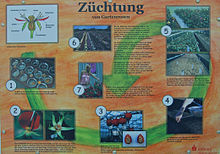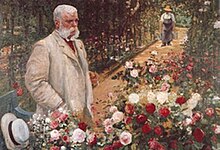Rose breeding
The rose cultivation leads cultivated roses to the formation of new roses varieties , the different breeding lines belong to the so-called Rose classes and Rose groups. While the term wild rose summarizes the botanical rose species that arose naturally, new varieties are the result of specifically selected sports or intentional crossings of already existing species and rose varieties, which are then propagated vegetatively for further production .
Methods
A breeder tries to expand and improve the properties of existing roses through targeted crossings with other species and varieties.
In addition, the rose breeder also observes the occurrence of random mutations on existing plants. These lead to the formation of so-called sports of a variety in horticulture , which are then also propagated vegetatively. The sport often has a different flower color , but can also have completely different growth characteristics than the mother variety.
Breeding goals
Important breeding goals are the continuous further development of:
- Flowering properties: flower color, flower filling , fragrance , self-cleaning , remontance
- Growth characteristics: vigor , disease resistance
- Environmental properties: hardiness to frost , resistance to rain and wind
- special breeding goals: suitability for pot culture , easy maintenance
“Blue” roses are the dream of every rose grower . But the conventional way of breeding blue roses is impossible, as the rose plants lack a gene for the blue dye . However, breeders like to indicate (almost) blue roses as well as (almost) black roses by naming them.
Awards
Particularly good varietal properties are awarded in competitions by rose test gardens . In Germany, the ADR label is awarded for particularly healthy, easy-care roses ( Recognized German Rose ). In addition, the Golden Rose of Baden-Baden is chosen annually in Baden-Baden , which is considered Rose of the Year in Germany .
There are also numerous awards abroad. The highest is the every three years by the World Rose Association crowned World Rose . Other well-known international awards for rose varieties include the RNRS Prize (Royal National Rose Society), the All American Rose Selection , the Henry Edland Memorial Medal , the St. Albans Prize , as well as the prices of the rose competitions in Paris ( Bagatelle , France), Rome (Italy), Madrid (Spain), Tokyo (Japan), Hamilton (New Zealand), Rose Hills (USA), Geneva (Switzerland), The Hague (Netherlands), Le Rœulx (Belgium) or in Baden near Vienna (Austria).
Rose growers themselves are also rewarded for their excellent breeding work, for example with the Dean Hole Medal and the Clay Challenger Prize (an English challenge award for the grower of the best scented rose).
Milestones in rose breeding
The first rose breeding in Germany by 1773 by Daniel August Schwarzkopf in true Kassel drawn and Wernt Grimm in Rose Park mountain park Wilhelmshöhe rediscovered Gallica Rose 'Pearl of Weissenstein'.
A turning point in rose breeding was in 1867 when the French gardener Jean Baptiste Gulliot discovered the hybrid tea 'La France' as a seedling . This marks the transition from old roses or classic roses to modern roses.
In recent times, the history of cultivated roses is closely linked to the names of rose breeders - often several generations of gardening families - who have driven the development of rose varieties in ever shorter cycles through breeding work since the 17th century .
List of rose growers
| Rose grower | born | died | country |
|---|---|---|---|
| Domenico Aicardi | 1878 | 1964 | Italy |
| John Armstrong | United States | ||
| David CH Austin | 1926 | 2018 | England |
| René Barbier | 1845 | 1931 | France |
| Karl Baum | 1911 | 2004 | Germany |
| Peter Beales | 1936 | 2013 | England |
| Jean Béluze | 1793 | 1869 | France |
| Henry Bennett | 1823 | 1890 | England |
| Ann and John A. Bentall | England | ||
| Vincenz Berger | 1883 | 1974 | Germany |
| Jan Boehm | 1888 | 1959 | Czech Republic |
| Eugene Boerner | United States | ||
| Franz Karl Brümmer | 1874 | 1948 | Germany |
| Max Buntzel | 1850 | 1907 | Germany |
| Maria Henrietta Chotek | 1863 | 1945 | Austria-Hungary |
| Griffith Buck | 1915 | 1991 | United States |
| Georges Delbard | 1906 | 1999 | France |
| Jacques-Louis Descemet | 1761 | 1839 | France |
| Dickson Nurseries Ltd. | Ireland | ||
| Pedro Dot | 1885 | 1976 | Spain |
| Claude Ducher | 1820 | 1874 | France |
| André Eve | 1931 | 2015 | France |
| Hans Jürgen Evers | 1940 | 2007 | Germany |
| Jean-Marie Gaujard | 1903 | 1995 | France |
| Gemen-Bourg | 1888 | Luxembourg | |
| Rudolf Geschwind | 1829 | 1910 | Austria-Hungary |
| Jules Gravereaux | 1844 | 1916 | France |
| Jean Baptiste Gulliot | 1803 | 1882 | France |
| Julien-Alexandre Hardy | 1781 | 1876 | France |
| Robert Harkness | 1851 | 1920 | England |
| Karl Hetzel | 1923 | 2003 | Germany |
| Richard Huber | 1927 | 2013 | Switzerland |
| Jackson & Perkins | United States | ||
| Chains Frères | 1867 | 1940 | Luxembourg |
| Hermann Kiese | 1865 | 1923 | Germany |
| Reimer Kordes | 1922 | 1997 | Germany |
| Wilhelm Kordes II. | 1891 | 1976 | Germany |
| Max Krause | 1880 | 1937 | Germany |
| Jean Laffay | 1795 | 1878 | France |
| JB Lamesch | 1871 | Luxembourg | |
| Peter Lambert | 1859 | 1939 | Germany / Luxembourg |
| Walter E. Lammerts | 1904 | 1996 | United States |
| Louis Lens | 1924 | 2001 | Belgium |
| Gergely Mark | 1923 | 2012 | Hungary |
| Samuel McGredy | Ireland | ||
| Meilland | France | ||
| Moreau-Robert | France | ||
| Ralph Moore | 1907 | 2009 | United States |
| Wilhelm Mill | 1845 | 1908 | Bohemia / Romania |
| Werner Noack | 1927 | Germany | |
| Louis Claude Noisette | 1772 | 1849 | France |
| Pierre Oger | 1816 | 1894 | France |
| Pernille Olesen | 1949 | Denmark | |
| William Paul | 1823 | 1905 | England |
| Louis Joseph Ghislain Parmentier | 1782 | 1847 | Belgium |
| Joseph Hardwick Pemberton | 1852 | 1926 | England |
| James Plaisted Wilde, Lord Penzance | 1816 | 1899 | England |
| Jean Pernet | 1832 | 1896 | France |
| Joseph Pernet-Ducher | 1859 | 1928 | France |
| Dorus Theus Poulsen | 1850 | 1925 | Denmark |
| Marcel Robichon | France | ||
| Gerrit de Ruiter | 1882 | 1965 | Netherlands |
| Ewald Scholle | 1934 | Germany | |
| Daniel August Schwartzkopf | around 1738 | 1817 | Germany |
| Rolf Sievers | 1938 | Germany | |
| Peter Strassheim | 1850 | 1923 | Germany |
| Soupert et Notting | 1956 | 1936 | Luxemburg succ. (1906-1936 Soupert Jean-Pierre; Pierre-Alphonse; Constant) Luxembourg |
| Herbert Swim | United States | ||
| Mathias Tantau | 1882 | 1953 | Germany |
| Mathias Tantau jun. | 1912 | 2006 | Germany |
| Victor Teschendorff | 1877 | 1960 | Germany |
| Graham Stuart Thomas | 1909 | 2003 | England |
| Walter van Vleet | 1857 | 1922 | United States |
| Jean-Pierre Vibert | 1777 | 1866 | France |
| Max Vogel | 1893 | 1949 | Germany |
| Christoph Weigand | 1839 | 1909 | Germany |
| Nicola Welter | 1854 | 1920 | Germany |
See also
literature
- Heinrich Schultheis: Roses: the best types and varieties for the garden. Ulmer, Stuttgart 1996, ISBN 3-8001-6601-1 .
- Annette Timmermann, Andrea Rausch: DuMont's little rose dictionary - varieties, origin, use and care . Edition Dörfler, Eggolsheim 2004, ISBN 3-89555-206-2 .
- Rosae Luxemburgenses, Lëtzebuerger Rousen gëschter an haut, Editor / Editeur: Lëtzebuerger Rousefrenn ASBL, Made in Luxemburg 2017, ISBN 978-99959-0-349-7





